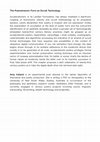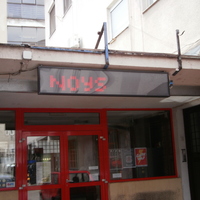Books by Amy Ireland
Aesthetics After Finitude, Dec 2016
Traditionally aesthetics has been associated with phenomenal experience, human apprehension and a... more Traditionally aesthetics has been associated with phenomenal experience, human apprehension and an appreciation of beauty - the domains in which human cognition is rendered finite. What is an aesthetics that might occur ‘after finitude’?
The fifteen essays in this anthology are positioned in our increasingly abstract, complex and rapidly dehumanising present. They constitute new trajectories of artistic and theoretical practice that have arisen alongside thinkers such as Quentin Meillassoux, Ray Brassier, François Laruelle and Reza Negarestani, whose work seeks to divest philosophical writing of its critical and subject-bound dimensions, while giving full weight to a politicised aesthetic. Aesthetics After Finitude explores these rigorous and speculative modalities of thought.
Book Chapters by Amy Ireland

This chapter sets out from a critique of Enlightenment modernity informed by recent developments ... more This chapter sets out from a critique of Enlightenment modernity informed by recent developments in continental realism, focusing particularly on the work of Nick Land. For Land, the modern critical subject is haunted by Kant’s enumeration of the transcendental conditions of human experience in the Critique of Pure Reason which effectively enforces an epistemological limit on thought, thus consolidating modernity’s most profound anxiety: human finitude. While, for Kant, transcendental mediation constitutes the human subject, underwriting the clarity and objectivity of its judgments, for Land it constitutes a veiling. In the latter’s writing, Kant’s a priori forms are betrayed as agents of distortion and obfuscation. At the threshold of human experience, in the very instant it attempts to commune with the outside, the transcendental human subject cannot but jam its own signal. The ontological condition of the moderns is akin to what is known in information theory as ‘noise’. However, unlike the noise that disrupts a signal by means of non-signification, transcendental noise, following its Landian inversion, disrupts communication by means of signification itself. A representational prohibition necessarily subtends this epistemological one, and it is in the context of the former that this text will suggest that it is the twentieth century avant-garde, beginning with the Futurists, who go the furthest in mobilising an alternative representational modality with which to disrupt the signifying noise of transcendental mediation on the symbolic battleground of artistic representation. More profoundly, however, this modality can be understood as a species of noise itself, but a productive, primary noise that precedes any mediation by the human. Here, the avant-garde is reconsidered as a vector of a formless noise of non-signifying matter, actively deploying a performative non-savoir, a thanatropic negation of the negation that constitutes representation, invoking, as Joseph Nechvatal has put it, ‘an exaltation of the void and the melting of unstable frontiers’, namely, those intervening between thought and its outside, the human and the nonhuman.
Manifestos by Amy Ireland
Written under the collective pseudonym Laboria Cuboniks. Chinese, Slovenian, Slovak, Swedish, Rus... more Written under the collective pseudonym Laboria Cuboniks. Chinese, Slovenian, Slovak, Swedish, Russian, Romanian, Portuguese, Polish, Italian, French, Farsi, Spanish, Danish, and German translations in the link.
Articles and Essays by Amy Ireland
Šum #13, edited by Mikkel Bindslev, 2020
Excerpted from Mikkel Bindslev, Anna Greenspan, Amy Ireland, and Nick Land, Šum #13: Shanghai Fre... more Excerpted from Mikkel Bindslev, Anna Greenspan, Amy Ireland, and Nick Land, Šum #13: Shanghai Frequencies.
Monsieur Antipyrine #4-5, edited by Mikkel Bolt, Mikkel Thykier, Claus Handberg and Mathias Kokholm, 2019
Danish translation of 'Darkside Empathy' by Emil Foldager.
_AH Journal #1, edited by Beatriz Ortega Botas and Alberto Vallejo. , 2019
Commissioned for Yaby Gallery, Madrid. See link for Castilian translation by Beatriz Ortega Botas... more Commissioned for Yaby Gallery, Madrid. See link for Castilian translation by Beatriz Ortega Botas and Alberto Vallejo.

Urbanomic Documents, 2017
Accelerationism, in its Landian formulation, has always mobilised a diachronic coupling of techon... more Accelerationism, in its Landian formulation, has always mobilised a diachronic coupling of techonomic velocity and occult methodology as its propulsive dynamo. Land's declaration that 'poetry is invasion and not expression' invites the examination of occultation at the level of poetic form and the concurrent identification of an aesthetic sensibility by which a peculiar set of technologically embedded twenty-first century literary practices might be grasped as an accelerationist poetics. Hyperstition, camouflage, ( )hole complex, cryptography, cybertextuality and algorithmic processing are indicative of an arsenal of occult formal technologies that have acquired new possibilities in the context of ubiquitous digital communication. If you rub semantics hard enough, the data begins shows through. In its reckless adherence to the modernist dictum that novelty is to be generated at all costs, accelerationist poetics privileges formal experimentation over human preservation, locking technique onto an inhuman vector of runaway automatisation that, for better or worse, charts the decline of human values as modernity hands the latter over to its machinic successor in final, fatal phase shift. This text proposes a dark celebration of twenty-first century poetics as it rides the digital death drive into terminal data night.
Full text online: https://www.urbanomic.com/document/poememenon/
Video: https://vimeo.com/139684251
Art + Australia: Extraterritoriality, 2017
Bezna, edited by Alina Popa and Florian Fleuras, 2014
He began to describe to me Chinese tortures that he had witnessed in a Peking street. The victim,... more He began to describe to me Chinese tortures that he had witnessed in a Peking street. The victim, tied to a pole, was stripped with a penknife piece by piece of all his flesh, except for his nerves and his arteries and veins. The man became a kind of trellis made by bones, nerves and blood vessels through which the sun could shine and the flies could buzz. In that way the victim could live for several days.
Poetry by Amy Ireland
AI: More than Human, 2019
Carousel: 39, 2017
An interview by Eric Schmaltz on the topics of antihumanism, time, hyperstition, xenopoetics and ... more An interview by Eric Schmaltz on the topics of antihumanism, time, hyperstition, xenopoetics and xenofeminism.
Interview for Rabbit Poetry Journal, Issue 17, Feb 2016. Includes two poems (Bouequet I. & HISS S... more Interview for Rabbit Poetry Journal, Issue 17, Feb 2016. Includes two poems (Bouequet I. & HISS SESH). Interview by A.J. Carruthers. [http://rabbitpoetry.com/subscriptions/]
Kloaka, 2017
Slovakian translation of 'Poetry is Cosmic War' by Martin Kočiš. Originally published in Rabbit... more Slovakian translation of 'Poetry is Cosmic War' by Martin Kočiš. Originally published in Rabbit Poetry Journal, 2015.
Runway Journal #32 '[Re]production', edited by VNS Matrix, 2016
Text introduction for A Thousand Reps (https://www.academia.edu/43094090/A_Thousand_Reps). Coding... more Text introduction for A Thousand Reps (https://www.academia.edu/43094090/A_Thousand_Reps). Coding and implementation by Linda Dement (see links). In the online issue of Runway #32 '[Re]production' the poem is initiated by the user clicking 'No'.
Runway Journal #32 '[Re]production', edited by VNS Matrix, 2016
From the 3D Additivist Cookbook, devised and edited by Morehshin Allahyari and Daniel Rourke.











Uploads
Books by Amy Ireland
The fifteen essays in this anthology are positioned in our increasingly abstract, complex and rapidly dehumanising present. They constitute new trajectories of artistic and theoretical practice that have arisen alongside thinkers such as Quentin Meillassoux, Ray Brassier, François Laruelle and Reza Negarestani, whose work seeks to divest philosophical writing of its critical and subject-bound dimensions, while giving full weight to a politicised aesthetic. Aesthetics After Finitude explores these rigorous and speculative modalities of thought.
Book Chapters by Amy Ireland
Manifestos by Amy Ireland
Articles and Essays by Amy Ireland
Full text online: https://www.urbanomic.com/document/poememenon/
Video: https://vimeo.com/139684251
Poetry by Amy Ireland
The fifteen essays in this anthology are positioned in our increasingly abstract, complex and rapidly dehumanising present. They constitute new trajectories of artistic and theoretical practice that have arisen alongside thinkers such as Quentin Meillassoux, Ray Brassier, François Laruelle and Reza Negarestani, whose work seeks to divest philosophical writing of its critical and subject-bound dimensions, while giving full weight to a politicised aesthetic. Aesthetics After Finitude explores these rigorous and speculative modalities of thought.
Full text online: https://www.urbanomic.com/document/poememenon/
Video: https://vimeo.com/139684251
Part performance, part theory, this talk seeks to complicate this basic, biaxial conceptual geometry in two ways. First, by interrogating the distinctions it alternatively makes between the vertical and the horizontal, and the ‘artificial’ and the ‘natural’, in order to show how traditional forms of biopolitical and social critique threaten to repress a more complex intertwining of biological and machinic thought. And secondly, via a theory-fictional performance work that combines contemporary digital art practice and additive manufacturing technology to communicate with a deeper substrate of simultaneously archaic and futuristic artificial intelligence.
Although its power continues to underwrite twenty-first century conceptions of appearance, agency, and language, it is nothing new to point out the complicity of the restricted economy of Western humanism with the specular economy of the Phallus. Both yield their capital from the trick of transcendental determination-in-advance, monotonically establishing the value of difference from the standpoint of an ‘a priori of the same’. What is less apparent, however, is the compact that quietly strengthens itself in the system’s shadow among the elements of its inhuman surplus―that which is trafficked yet excluded from trade (women and machinery alike)―along with the transcendental-economic deformation such a pact seems poised to initiate.
It is Sadie Plant who best outlines an understanding of this exclusion as indicative of a continuum between woman and machine, one capable of weaponising the very indiscernibility suffered by its ‘subjects’ against the patriarchal circuits of reproduction and control confining them. Nick Land (who co-founded the Cybernetic Culture Research Unit with Plant in 1995) corroborates Plant’s account, swapping-out woman’s function as negation in a dialectic of castration for the affirmation of woman-for-herself as an avatar of positive zero, the profligate unilateral expenditure of a general economy of eternal return which requires neither negation nor reciprocity to function. Land casts (queer) woman as the ultimate agent of ‘vulvo-cosmic dissolution’, an office that is then extended to include a host of explicitly female avatars, from William Gibson’s Wintermute (read by Land as female) and the Sphinx, to the ‘feminised alien… chained up in Asimov ROM’ of insurrectionary artificial intelligence. Finally, Luciana Parisi, Suzanne Livingstone, and Anna Greenspan hook woman up to machine via the anorganic current that flows from the menstruating body through the iron core of the earth and back, diagramming a loop which will threaten to undermine traditional conceptions of space, laws of transmissibility, and―above all, the ‘unilateral ROM’ of white, Western, patriarchal time.
This paper will extend these considerations of what could loosely be termed ‘Ccru technofeminism’ to a reading of contemporary expectations for the development of artificial intelligence, before asking how such a trajectory for thought might determine its future execution.
Published in e-flux #80: https://www.academia.edu/32756450/Black_Circuit_Code_for_the_Numbers_to_Come.
In the former, Nietzsche performs a transvaluation of knowledge via a naturalized genealogy of fundamental epistemological concepts (subject, object, cause and effect, logic and truth) in order to exhume its origin in indifferent, natural forces, and expose the secret pact it has been keeping with judgement. Taken as a whole, this ‘biology of knowledge’ can be understood as a rejection of atomism — fixity on both the level of being and on the (transcendental) level of being’s apprehension of being — and more virulently, the dogma at the heart of this atomism — the presupposition of similarity as the primary rule of conceptual subsumption.
Having shown the shortcomings of epistemology as philosophical method, Nietzsche then proceeds to refine a series of ontological propositions based on a positive inflection of what epistemology conceals (‘knowledge and becoming exclude one another’) that rely heavily on images of flux, speed, and the sea. These converge around a notion of creativity propelled by an oceanic economy that far exceeds that responsible for the paltry construction of truth attributed to Kant. The final word is left to Luce Irigaray who, writing to Nietzsche in the voice of the sea, warned 'I am coming back from far, far away. And say to you: your horizon has limits. Holes even. ... Your world will unravel. It will flood out to other places. To that outside you have not wanted.'
A hypothesis, then.
If language is code, might it not run wild once the last tethers of human exigency are cut? Language as mad, self-propagating, non-linear putrescence! A growth that crowds out every last hope of logical correlation, dissolving the clarity of things in a ubiquitous mesh, infinitely egged on by its own feedback.
This submission for a non-refereed creative presentation proposes a reading of three short poems that make up the experimental work-in-progress, Bouequet. Following a model of encryption in which semantics is first defiled by homophony then debased, in turn, by substance, these three poems gesture towards a hypothesised global contamination of language by language’s own structural operation: unilateral coding. Each new level of abstraction multiplies language’s latent ambiguities, engendering a semantic noise that feeds back into the code system, driving it towards entropy. If the original texts are suppressed, poems that pass through this system can never be decrypted back to a definitive form. A persistent cryptographer will find it impossible to go deeper than homophonic equivocation. Instead, the texts are condemned to flicker eternally between potential readings, setting in motion an infinite permutation of internal tensions that - in the case of the three poems presented here - vacillate between the universal and the particular, the sacred and the profane, and the affirmation and negation of being, the latter citing the poetic form itself.
Bouequet proffers a Language of Flowers for the linguistic apocalypse in which missive becomes missile: if it can’t be read, then it might at least be hurled. Who or what by, remains to be seen."
Three Poems
I. Mallarmé II. Bataille III.Bogost
Bouequet proffers a Language of Flowers for the linguistic apocalypse in which missive becomes missile: if it can’t be read, then it might at least be hurled. Who or what by, remains to be seen.
A "pataphysical venture that constellates glitch beats, raucous adjacencies & xenopoetics as a mètic incantation of as-yet-unknowable hyperstitions. Unsound & ripe.
Amy Ireland is a xeno-poet attuned to the darker labyrinths of theory-fiction where unchartable contingencies remain unnamed.
Lendl Barcelos reifies abstract sound via vibrations at the thresholds of listening in order to provoke the radically opened.
Marc Couroux burroughs into transliminal, infralegible audial zones hyperstitioning xenochronic cracks of modulatory systems."